11.4 Assess Your UnderstandingPrinted Page 792
Concepts and Vocabulary
True or False If a twice differentiable vector function r(t)=x(t)i+y(t)j+z(t)k represents the position of a particle moving along a smooth curve, then the velocity vector is v(t)=r′(t) and the acceleration vector is a(t)=r′′(t).
True
True or False If a particle moving along a smooth curve traced out by a twice differentiable vector function r=r(t) travels at a constant speed, then the acceleration of the particle is directed along the unit tangent vector T.
False
True or False The acceleration vector a=a(t) of a particle moving along a smooth curve traced out by a twice differentiable vector function r=r(t) can be written as the sum of two orthogonal vectors: one vector in the direction of the velocity and the other vector perpendicular to the direction of the velocity.
True
When the acceleration vector a(t) of a particle moving along a smooth curve is written as a(t)=v′(t)T(t)+[v(t)]2κN(t), then aT=v′(t) is called the _____ component and aN=[v(t)]2κ is called the _____ component of the acceleration vector a.
Tangential, normal
793
Skill Building
In Problems 5–10:
- (a) Find the velocity, acceleration, and speed of a particle whose motion is along the plane curve traced out by the vector function r=r(t).
- (b) For each curve, graph the motion of the particle and the vectors v(0) and a(0).
r(t)=ti+t2j
- (a) v(t)=i+2tj, a(t)=2j, and v(t)=√1+4t2
- (b)
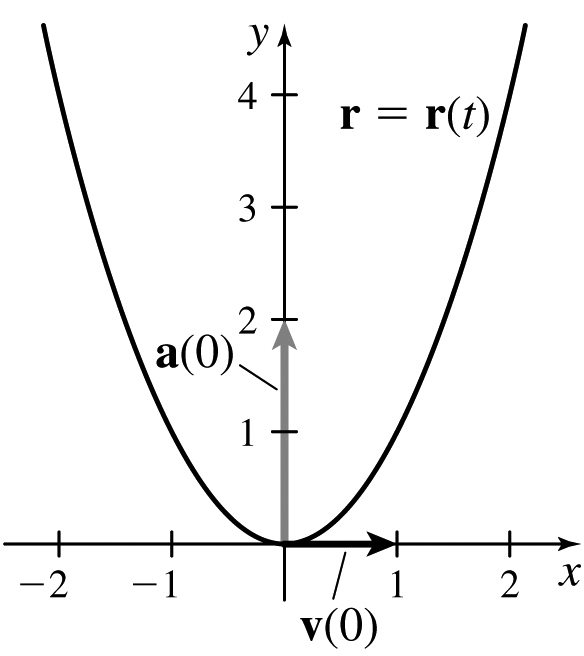
r(t)=ti−t3j
r(t)=(t2+1)i+(1−t)j
- (a) v(t)=2ti−j, a(t)=2i, and v(t)=√4t2+1
- (b)
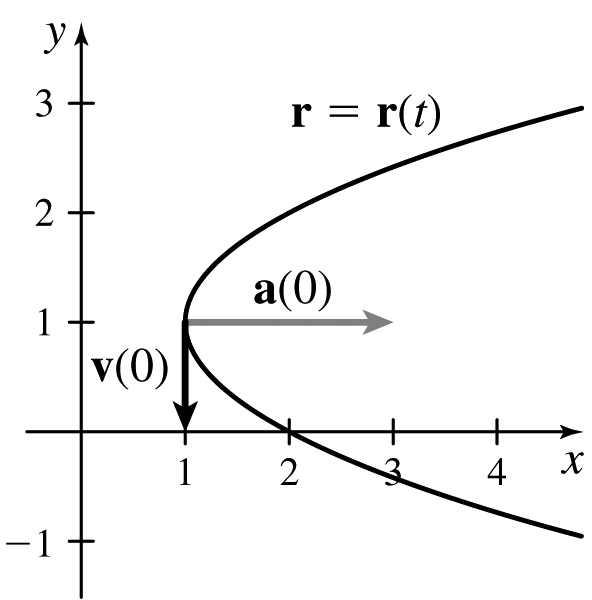
r(t)=t3i+3tj
r(t)=4ti−t3j
- (a) v(t)=4i+3t2j, a(t)=6tj, and v(t)=√16+9t4
- (b)
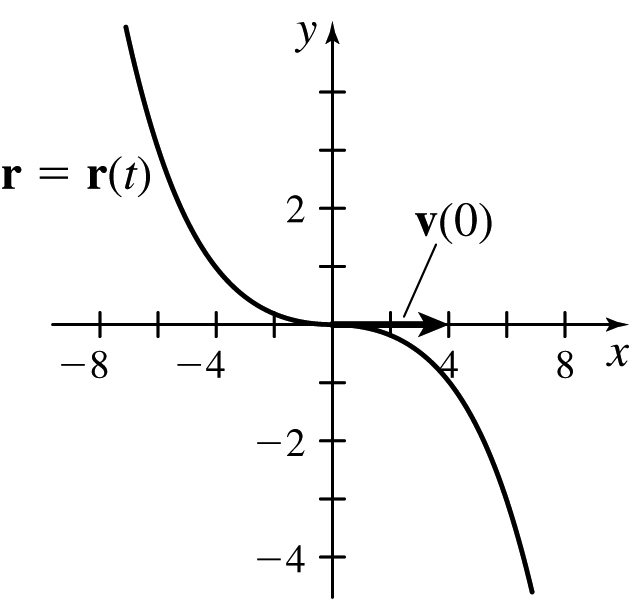
r(t)=t3i+12tj
In Problems 11–16, find the velocity, acceleration, and speed of a particle whose motion is along the space curve traced out by the vector function r=r(t).
r(t)=t2i+tj−3t3k
v(t)=2ti+j−9t2k, a(t)=2i−18tk, and v(t)=√81t4+4t2+1
r(t)=(t+1)i+6tj+t2k
r(t)=√16−t2i+t2j+tk
v(t)=−t√16−t2i+2tj+k, a(t)=−16(16−t2)3/2i+2j, and v(t)=√t216−t2+4t2+1
r(t)=1t2i+t+1t2j+tk
r(t)=2costi+sintj+tk
v(t)=−2sinti+costj+k, a(t)=−2costi−sintj, and v(t)=√3sin2t+2
r(t)=ti+sin(4t)j+cos(4t)k
In Problems 17 and 18:
- (a) Find the velocity, acceleration, and speed of a particle whose motion is along the space curve traced out by the vector function r=r(t)
- (b) Evaluate v(t), a(t), and v(t) at the given t.
- (c)
 Graph the space curve traced out by r=r(t). On the same screen graph the velocity vector and acceleration vector at the given value of t.
Graph the space curve traced out by r=r(t). On the same screen graph the velocity vector and acceleration vector at the given value of t.
r(t)=sinti+costj+sin(2t)k,t=π2
- (a) v(t)=costi−sintj+2cos(2t)k, a(t)=−sinti−costj−4sin(2t)k, and v(t)=√1+4cos2(2t)
- (b) v(π2)=−j−2k, a(π2)=−i, and v(π2)=√5
- (c)

r(t)=sinti+costj+√tk,t=π
In Problems 19–26, a particle of mass m is moving along the curve traced out by the vector function r=r(t).
- (a) Find the force acting on the particle at any time t.
- (b) Find the magnitude of the acceleration of the particle.
r(t)=eti+e−tj
- (a) F(t)=mr(t)
- (b) ‖
\mathbf{r}(t)=e^{2t}\mathbf{i}+e^{-t}\mathbf{j}
\mathbf{r}(t)=t\mathbf{i}+e^{t}\mathbf{j}
- (a) \mathbf{F}(t) = m \, e^t \mathbf{j}
- (b) \left\Vert\mathbf{a}(t) \right\Vert = e^t
\mathbf{r}(t)=t\mathbf{i}+\ln (1+t)\mathbf{j}
\mathbf{r}(t)=3\sin ( 2t) \mathbf{i}+3\cos ( 2t) \mathbf{j}
- (a) \mathbf{F}(t) = -4m\bf{r}(t)
- (b) \left\Vert\mathbf{a}(t) \right\Vert = 12
\mathbf{r}(t)=4\sin t\mathbf{i}-4\cos t\mathbf{j}
\mathbf{r}(t)=2\cos t\mathbf{i}-3\sin t\mathbf{j}
- (a) \mathbf{F}(t) = -m\mathbf{r}(t)
- (b) \left\Vert\mathbf{a}(t) \right\Vert = \sqrt{5\sin^2t+4}
\mathbf{r}(t)=-\cos ( 3t) \mathbf{i}+2\sin ( 3t) \mathbf{j}
In Problems 27–44:
- (a) Find the velocity, acceleration, and speed of a particle traveling along the curve traced out by the vector function \mathbf{r}=\mathbf{r}(t).
- (b) Find the tangential and normal components of the acceleration.
\mathbf{r}(t)=2t\mathbf{i}+(t+1)\mathbf{j}
- (a) \mathbf{v}(t) = 2\mathbf{i}+\mathbf{j}, \mathbf{a}(t) = 0, and v(t) = \sqrt{5}
- (b) a_{\mathbf T} = 0, a_{\mathbf N} = 0
\mathbf{r}(t)=(1-3t)\mathbf{i}+2t\mathbf{j}
\mathbf{r}(t)=e^{t}\mathbf{i}+e^{2t}\mathbf{j}
- (a) \mathbf{v}(t) = e^t \mathbf{i} + 2 e^{2t} \mathbf{j}, \mathbf{a}(t) = e^t\mathbf{i} +4e^{2t}\mathbf{j}, and v(t) = e^t \sqrt{1+4e^{2t}}
- (b) a_{\mathbf T} = \dfrac{e^t (1+8e^{2t})}{\sqrt{1+4e^{2t}}}, a_{\mathbf N} = \dfrac{2e^{2t}}{\sqrt{1+4e^{2t}}}
\mathbf{r}(t)=e^{-t}\mathbf{i}+e^{-2t}\mathbf{j}
\mathbf{r}(t)=2\sin t\mathbf{i}+\cos t\mathbf{j}
- (a) \mathbf{v}(t) = 2 \cos t \mathbf{i} - \sin t \mathbf{j}, \mathbf{a}(t) = -2\sin t \mathbf{i} - \cos t \mathbf{j}, and v(t) = \sqrt{3\cos ^2t +1}
- (b) a_{\mathbf T} = -\dfrac{3 \sin t \cos t}{\sqrt{3\cos ^2t +1}}, a_{\mathbf N} = \dfrac{2}{\sqrt{3\cos ^2t +1}}
\mathbf{r}(t)=2\cos t\mathbf{i}+3\sin t\mathbf{j}
\mathbf{r}(t)=(1-3t)\mathbf{i}+2t\mathbf{j}-(5+t)\mathbf{k}
- (a) \mathbf{v}(t) = -3\mathbf{i}+2\mathbf{j}-\mathbf{k}, \mathbf{a}(t) = \mathbf{0}, and v(t) = \sqrt{14}
- (b) a_{\mathbf T} = 0, a_{\mathbf N} = 0
\mathbf{r}(t)=(2+t)\mathbf{i}+(2-t)\mathbf{j}+3t\mathbf{k}
\mathbf{r}(t)=t\mathbf{i}+t^{2}\mathbf{j}+t^{3}\mathbf{k}
- (a) \mathbf{v}(t) = \mathbf{i} + 2t \mathbf{j} + 3t^2 \mathbf{k}, \mathbf{a}(t) = 2\mathbf{j}+6t \mathbf{k}, and v(t) = \sqrt{1+4t^2+9t^4}
- (b) a_{\mathbf T} = \dfrac{18t^3+4t}{\sqrt{1+4t^2+9t^4}}, a_{\mathbf N} = \dfrac{2{\sqrt{1+9t^2+9t^4}}}{\sqrt{1+4t^2+9t^4}}
\mathbf{r}(t)=\dfrac{t^{2}}{t+1}\mathbf{i}+\dfrac{1}{t+1}\mathbf{j}+\dfrac{t}{t+1}\mathbf{k}
\mathbf{r}(t)=3\mathbf{i}+\cos t\mathbf{j}+\sin t\mathbf{k}
- (a) \mathbf{v}(t) = -\sin t \mathbf{j} + \cos t \mathbf{k}, \mathbf{a}(t) = -\cos t \mathbf{j} - \sin t \mathbf{k}, and v(t) = 1
- (b) a_{\mathbf T} = 0, a_{\mathbf N} = 1
\mathbf{r}(t)=t\mathbf{i}+\sin t\mathbf{j}+\cos t\mathbf{k}
\mathbf{r}(t)=\ln t\mathbf{i}+\sqrt{t}\mathbf{j}+t^{3/2}\mathbf{k}; t>0
- (a) \mathbf{v}(t) = \dfrac1t \mathbf{i}+\dfrac1{2\sqrt{t}}\mathbf{j} + \dfrac{3\sqrt{t}}2 \mathbf{k}, \mathbf{a}(t) = -\dfrac{1}{t^2}\mathbf{i}-\dfrac{1}{4t^{3/2}}\mathbf{j} + \dfrac{3}{4 \sqrt{t}}\mathbf{k}, and v(t) = \dfrac{\sqrt{9t^3 +t +4}}{2t}
- (b) a_{\mathbf T} = \dfrac{9t^3-t-8}{4t^2\sqrt{9t^3 +t +4}}, a_{\mathbf N} = \dfrac{\sqrt{9t^3+81t^2+1}}{2t^{3/2}\sqrt{9t^3 +t +4}}
\mathbf{r}(t)=\cos ( 2t) \mathbf{i}+\sin ( 2t) \mathbf{j}-5\mathbf{k}
\mathbf{r}(t)=e^{t}\cos t\mathbf{i}+e^{t}\sin t\mathbf{j}+e^{t}\mathbf{k}
- (a) \mathbf{v}(t)\,{=}\,(e^t \cos t - e^t \sin t) \mathbf{i} + (e^t \sin t + e^t \cos t) \mathbf{j} + e^t \mathbf{k}, \mathbf{a}(t)\,{=}\,-2e^t \sin t \mathbf{i} + 2 e^t \cos t \mathbf{j} +e^t \mathbf{k}, and v(t)\,{=}\,\sqrt{3}e^t
- (b) a_{\mathbf T}\,{=}\,\sqrt{3}e^t, a_{\mathbf N}\,{=}\,\sqrt{2}e^t
\mathbf{r}(t)=e^{-t}\cos t\mathbf{i}+e^{-t}\sin t\mathbf{j}-e^{-t}\mathbf{k}
\mathbf{r}(t)=a\cos t\mathbf{i}+b\sin t\mathbf{j}+ct\mathbf{k} ; a>0, b>0, c>0
- (a) \mathbf{v}(t) = -a \sin t \mathbf{i} + b \cos t \mathbf{j} + c \mathbf{k}, \mathbf{a}(t) = -a \cos t \mathbf{i} - b \sin t \mathbf{j}, and v(t) = \sqrt{a^2 \sin ^2 t + b ^2 \cos ^2 t + c ^2}
- (b) a_{\mathbf T} = \dfrac{(a^2-b^2)(\sin t \cos t)}{\sqrt{a^2 \sin ^2 t + b ^2 \cos ^2 t + c ^2}}, a_{\mathbf N} = \sqrt{\dfrac{b^2 c^2 \sin^2 t + a^2 c^2 \cos^2t + a^2 b^2}{a^2 \sin ^2 t + b ^2 \cos ^2 t + c ^2}}
\mathbf{r}(t)=\cosh t\mathbf{i}+\sinh t\mathbf{j}+t\mathbf{k}
Applications and Extensions
Velocity and Acceleration Find the velocity and acceleration of a particle moving on the cycloid \mathbf{r}( t)\;=\;[ \pi t-\sin ( \pi t) ]\kern.7pt \mathbf{i}\,+ [ 1-\cos ( \pi t) ]\,\mathbf{j}\kern.7pt
\mathbf{v}(t) = (\pi - \pi \cos(\pi t))\mathbf{i}+\pi \sin(\pi t) \mathbf{j}, \mathbf{a}(t) = \pi^2 \sin(\pi t) \mathbf{i} + \pi ^2 \cos (\pi t) \mathbf{j}
Velocity and Acceleration
- (a) Find the velocity and acceleration of a particle moving on the parabola \mathbf{r}( t) =( t^{2}-2t) \mathbf{i}+t\mathbf{j}.
- (b) At what time t is the speed of the particle 0?
Acceleration A particle moves along the path y=3x^{2}-x^{3} with the horizontal component of the velocity equal to \dfrac{1}{3}. Find the acceleration at the points where the velocity \mathbf{v} is horizontal. Graph the motion and indicate \mathbf{v} and \mathbf{a} at these points.
\mathbf{a}(0) = \dfrac23 \mathbf{j} and \mathbf{a}(6)=-\dfrac23 \mathbf{j}

Show that if the speed of a particle along a curve is constant, then the velocity and acceleration vectors are orthogonal.
If a particle moves along the graph of y=f(x), show that a_{\mathbf{N}}=0 at a point of inflection of the graph.
See the Student Solutions Manual.
Suppose that the vector function \mathbf{r}(t)=e^{t}\mathbf{i} +e^{-t}\mathbf{j} gives the position of a particle at time t.
- (a) Show that the force on the particle is directed away from the origin.
- (b) What is the minimum speed of the particle and where does it occur?
- (c) Find the tangential and normal components of the acceleration at the point found in (b).
- (d) The answers to (c) are a_{\mathbf{T}}=0 and a_{\mathbf{N}}= ||\mathbf{a}(t)||=\sqrt{2}. How could these have been predicted?
A particle moves along the graph y=\dfrac{1}{2}x^{2} with constant speed v_{0}=2. Find a_{\mathbf{T}} and a_{\mathbf{N}} in terms of x alone at a general point \left( x,\dfrac{1}{2}x^{2}\right) on the graph.
a_{\mathbf T} = 0 and a_{\mathbf N} = \dfrac{4}{(1+x^2)^{3/2}}
If the motion of a particle is along the curve traced out by \mathbf{r}(t)=\alpha \cosh t\mathbf{i}+\beta \sinh t\mathbf{j}, where \alpha >0 and \beta >0, show that the force acting on the particle is in the direction of \mathbf{r}= \mathbf{r}(t).
794
Centripetal Force Refer to Example 5.
- (a) If the speed of the motorcycle is increased by 10%, by how much does the frictional force on the tires need to increase to keep the motorcycle moving along the same path?
- (b) If the radius of the circular track is halved, how much more slowly should the motorcycle be driven so the frictional force doesn’t change?
- (a) 350 N
- (b) 35 km/h slower
Frictional Force A race car with mass 1000 kg is driven at a constant speed of 200 km/h around a circular track whose radius is 75 m. What frictional force must be exerted by the track on the tires to keep the car from skidding?
Particle Collider The Large Hadron Collider (LHC), buried 100 m beneath Earth’s surface, is located near Geneva, Switzerland, and spans the border between France and Switzerland. The LHC is 26,659 m in circumference and, at full power, protons travel at a speed of 299{,}792{,}455.3 m/s (99.9999991% the speed of light) around the circle. Find the magnitude of force necessary to keep a proton of mass m moving at this speed.
Source: http://public.web.cern.ch.
2.118 \times 10^{13}m\;\mathrm{N}
Particle Collider At the Fermi National Accelerator Laboratory in Batavia, Illinois, protons were accelerated along a circular route with radius 1 km. Find the magnitude of the force necessary to give a proton of mass m a constant speed of 280{,}000 km/s.
Magnitude of a Force Find the maximum magnitude of the force acting on a particle of mass m whose motion is along the curve \mathbf{r} (t)=4\cos t\mathbf{i}-2\cos ( 2t) \mathbf{j}.
4 \sqrt{5} m
Curvature of the Path of a Golf Ball A golf ball is hit with an initial speed v_{0} at an angle \theta to the horizontal and travels on a smooth curve traced out by the vector function \mathbf{r}=\mathbf{r}(t)= ( v_{0}\cos \theta ) t\mathbf{i}+\left[ ( v_{0}\sin \theta ) t -\dfrac{1}{2}gt^{2}\right] \mathbf{j},
where g=9.8{ m}/{ s}^{2} and 0\leq \theta \leq \dfrac{\pi }{2}.
- (a) At the highest point in the ball's trajectory, find the curvature of its path.
- (b) At the highest point in its trajectory, express the ball's acceleration vector using tangential and normal components. Are these components physically reasonable? Explain why.
Velocity A particle moves on the circle x^{2}+y^{2}=1 so that at time t\geq 0 the position is given by the vector \begin{equation*} \mathbf{r}(t)=\frac{1-t^{2}}{1+t^{2}}\mathbf{i}+\frac{2t}{1+t^{2}}\mathbf{j} \end{equation*}
- (a) Find the velocity vector.
- (b) Is the particle ever at rest? Justify your answer.
- (c) Give the coordinates of the point that the particle approaches as t increases without bound.
- (a) \mathbf{v}(t) = -\dfrac{4t}{(t^2+1)^2 }\mathbf{i} - \dfrac{2 (t^2-1)}{(t^2+1)^2} \mathbf{j}
- (b) No
- (c) (-1,0)
Velocity The position of a particle at time t\geq 0 is given by \mathbf{r}( t)\;=\;e^{-t}\cos t\mathbf{i}+e^{-t}\sin t \mathbf{j}.
- (a) Show that the path of the particle is part of the spiral r=e^{-\theta} (in polar coordinates).
- (b) Graph the path of the particle and indicate its direction of travel.
- (c) Show that the angle between the vector \mathbf{r} and velocity vector \mathbf{v} is always 135{{}^\circ}.
Oscillating Motion Suppose a particle moves along the curve traced out by \mathbf{r}(t)=4\cos t\mathbf{i}-2\cos ( 2t) \mathbf{j}.
- (a) Show that the particle oscillates on an arc of a parabola.
- (b) Graph the path.
- (c) Find the acceleration \mathbf{a} at points of zero velocity.
- (a) See the Student Solutions Manual.
- (b)
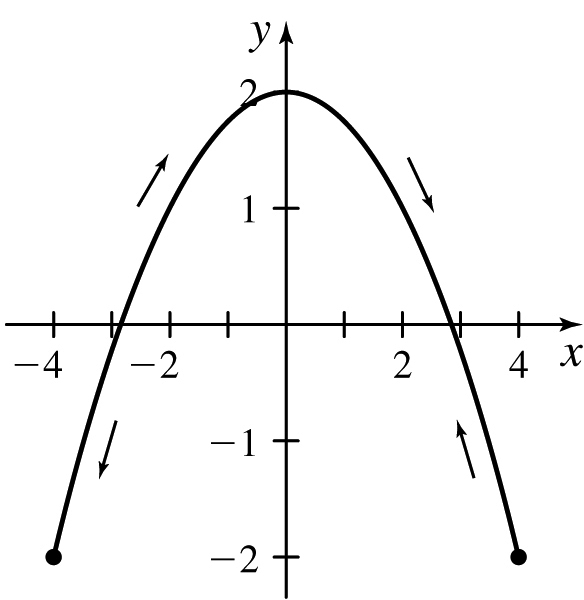
- (c)

If \mathbf{r}^{\prime} (t)=\mathbf{b}\times \mathbf{r}(t) for all t, where \mathbf{b} is a constant vector, show that the acceleration \mathbf{a}(t) is perpendicular to \mathbf{b} and that the speed is constant.
Mars Orbit NASA's Odyssey orbiter has a new mission to relay directly back to Earth the UHF telemetry taken by Curiosity, which landed on Mars on August 6, 2012. Odyssey is in a 'near-Mars' orbit at a height of 400\textrm {km} above its surface. Find the speed of the Odyssey if the acceleration due to gravity on Mars is 3.71\textrm{ m}/\textrm{s}^{2} and Mars' radius is 3390\textrm{ km}.
v \approx 3750 m/s

Physics The power expended by a force \mathbf{F}(t) acting on an object of mass m with velocity \mathbf{v}(t) is the dot product \hbox{Power}=\mathbf{F}(t)\,{\cdot}\, \mathbf{v}(t) The kinetic energy of an object of mass m and velocity \mathbf{v}(t) equals one-half the product of its mass times the square of its speed: \hbox{Kinetic energy}=\frac{1}{2}m\left\Vert \mathbf{v}(t)\right\Vert ^{2} Show that the power of an object equals the rate of change of its kinetic energy with respect to time.
Momentum In classical mechanics, the momentum \mathbf{p}(t) of an object of mass m at time t is defined as \mathbf{p}(t)=m\mathbf{v}(t), where \mathbf{v}(t) is the velocity of the object at time t. Show that force equals the rate of change of momentum with respect to time.
See Student Solutions Manual.
Angular Momentum The torque {\tau } (Greek letter tau) produced by a force \mathbf{F}(t) acting on an object whose position at time t is \mathbf{r}(t) is defined as {\tau }(t)=\mathbf{r}(t)\times \mathbf{F}(t). Torque measures the twist imparted on the object by the force. See the figure below. The angular momentum \mathbf{L} of an object of mass m and velocity \mathbf{v}(t) whose position at time t is \mathbf{r}(t) is \mathbf{L}(t)=\mathbf{r} (t)\times m\mathbf{v}(t). Show that the rate of change of angular momentum with respect to time equals the torque.

795
Central Fields of Force A central field of force \mathbf{F}(t) is one whose direction is parallel to that of the position \mathbf{r}=\mathbf{r}(t) of the object it acts upon; that is, \mathbf{F}(t)=u(t)\mathbf{r}(t), where u(t) is a scalar function. Show that a central field of force produces zero torque.
See Student Solutions Manual.
Hydrogen Atom The Bohr model of an atom views it as a miniature solar system, with negative electrons in circular orbits around the positive nucleus. A hydrogen atom consists of a single electron in orbit around a single proton. The electric force F_{\rm {elec}} that the proton of charge e=1.60\times 10^{-19}\textrm {C} exerts on the electron, also of charge e=1.60\times 10^{-19}\textrm {C}, is F_{\rm {elec}}=\dfrac{ke^{2}}{ r^{2}}, where r is the distance in meters between the nucleus and the electron and k=9.0\times 10^{9}\textrm {N}\,{\cdot} \textrm {m}^{2}\!/\textrm {C} is a constant. Apply Newton's Second Law of Motion to the electron in a hydrogen atom and show that its speed is v=\sqrt{\dfrac{ke^{2}}{mr}}, where m=9.11\times 10^{-31}\textrm {kg} is the mass of the electron.
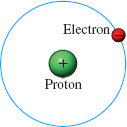
Analyzing Forces Use the formula \begin{equation*} \mathbf{F}=m\mathbf{a}=m\frac{dv}{dt}\mathbf{T}+mv^{2}\kappa\mathbf{N} \end{equation*} to discuss the forces on a passenger in a car.
- (a) What force corresponds to the push against the seat experienced by the passenger when the accelerator is depressed?
- (b) What force corresponds to the push against the door experienced by the passenger when the car is going around a curve?
- (c) How does this second force vary with the curvature of the road?
- (d) How does it vary with the speed of the car?
Answers will vary.
Analyzing Motion Suppose \mathbf{r}=\mathbf{r}(t) gives the position of a particle at time t. If the normal component of acceleration equals 0 at any time t, explain why the motion of the particle must be in a straight line.
Suppose the position of a particle in space is given by the vector function \mathbf{r}=\mathbf{r}( t) . Show that if \mathbf{r}=\mathbf{r}( t) lies on a sphere, then the tangent vector is always orthogonal to \mathbf{r}=\mathbf{r}( t) \mathbf{ }.
See Student Solutions Manual.
Challenge Problems
Coriolis Acceleration A particle moves on a disk from the center directly toward the edge. See the figure. The disk has radius 1 and is revolving in the counterclockwise direction at a constant angular speed \omega , so the position of a point on the edge of the disk is given by \mathbf{R}(t)=\cos ( \omega t) \mathbf{i}+\sin ( \omega t) \mathbf{j}. Suppose the position of the particle at time t is \mathbf{r}( t)\;=\;t\mathbf{R}( t) .
(a) Show that the velocity \mathbf{v} of the particle is \begin{equation*} \mathbf{v}=\cos ( \omega t) \mathbf{i}+\sin ( \omega t) \mathbf{j}+t\mathbf{v}_{\mathbf{d}} \end{equation*}
where \mathbf{v}_{\mathbf{d}}=\mathbf{R}^{\prime} (t) is the velocity of the rotating disk.
(b) Also show that the acceleration \mathbf{a} of the particle is \begin{equation*} \mathbf{a}=2\mathbf{v}_{\mathbf{d}}+t\mathbf{a}_{\mathbf{d}} \end{equation*}
where \mathbf{a}_{\mathbf{d}}=\mathbf{R}^{\prime \prime} (t) is the acceleration of the rotating disk. The extra term 2\mathbf{v}_{\mathbf{d}} is called the Coriolis acceleration, which results from the interaction of the rotation of the disk and the motion of the particle on the disk.

Coriolis Acceleration Refer to Problem 72.
(a) Find the velocity and acceleration of a particle revolving on a rotating disk according to \begin{equation*} \mathbf{r}(t)=t^{2}\cos ( \omega t) \mathbf{i}+t^{2}\sin ( \omega t) \mathbf{j} \end{equation*}
(b) What is the Coriolis acceleration?
- (a) \mathbf{v}(t) = 2t \cos (\omega t) \mathbf{i} + 2t \sin (\omega t) \mathbf{j} + t^2 \mathbf{v_d} and \mathbf{a}(t) = 2 \cos (\omega t) \mathbf{i} + 2 \sin (\omega t) \mathbf{j} + 4t \mathbf{v_d} + t^2 \mathbf{a_d}
- (b) 2 \cos (\omega t) \mathbf{i} + 2 \sin (\omega t) \mathbf{j} + 4t \mathbf{v_d}
Suppose a curve C is traced out by the vector function \mathbf{r}=\mathbf{r}(t). Find two nonparallel vectors that are orthogonal to \mathbf{T}(t) other than the principal unit normal vector. Assume \mathbf{T}(t)\neq \mathbf{0} and \mathbf{N}(t)\neq \mathbf{0}.
Let \mathbf{u}_{r}=\cos \theta \mathbf{i}+\sin \theta \mathbf{j} and \mathbf{u}_{\theta }=-\!\sin \theta \mathbf{i}+\cos \theta \mathbf{j}.
- (a) Show that \mathbf{u}_{r} and \mathbf{u}_{\theta } are unit orthogonal vectors.
- (b) Show that \dfrac{d\mathbf{u}_{r}}{d\theta }=\mathbf{u}_{\theta } and \dfrac{d\mathbf{u}_{\theta }}{d\theta }=-\mathbf{u}_{r}.
- (c) Suppose that \mathbf{r}(t) is the position vector of a plane curve and that the tip of \mathbf{r}(t) has polar coordinates (r(t),~\theta (t)) . Show that \mathbf{r}(t)=\;\left\Vert \mathbf{r}(t)\right\Vert \mathbf{u}_{r}=r(t) \mathbf{u}_{r}(t).
- (d) Use the Chain Rule to show that \begin{equation*} \mathbf{v}(t)=\frac{dr}{dt}\mathbf{u}_{r}+r\frac{d\theta }{dt}\mathbf{u} _{\theta }=r^{\prime} \mathbf{u}_{r}+r\theta ^{\prime} \mathbf{u}_{\theta } \end{equation*}
- (e) Show that \mathbf{a}(t)=[ r^{\prime \prime} -r( \theta ^{\prime}) ^{2}]\kern.7pt \mathbf{u}_{r}+[ r\theta ^{\prime \prime} +2r^{\prime}\theta ^{\prime} ]\kern.7pt \mathbf{u}_{\theta }.
See Student Solutions Manual.
Express the velocity \mathbf{v} and acceleration \mathbf{a} in terms of \mathbf{u}_{r} and \mathbf{u}_{\theta } for a motion along the polar curve r=2+\cos t, where \theta\;=\;2t.
Find polar coordinate equations for \mathbf{r}(t)=e^{2t}\cos t\mathbf{i}+e^{2t}\sin t\mathbf{j} and express the velocity \mathbf{v} and acceleration \mathbf{a} in terms of \mathbf{u}_{r} and \mathbf{u}_{\theta }.
r = e^{2t}, where \theta=t; \mathbf{v}(t) = 2r\mathbf{u}_r + r \mathbf{u}_\theta; \mathbf{a}(t) = 3r\mathbf{u}_r + 4r \mathbf{u}_\theta
- (a) Show that if \mathbf{r^{\prime} }(t)\,{\cdot}\, \mathbf{r}(t)=0 for all t, then the motion \mathbf{r}(t) is on the surface of a sphere centered at the origin.
- (b) What can be said about a motion for which \mathbf{r}^{\prime \prime} (t)\,{\cdot}\, \mathbf{r}^{\prime} (t)=0 for all t?
- (c) What can be said about a motion for which \mathbf{r}^{\prime} (t)\times \mathbf{r}(t)=0 for all t?
